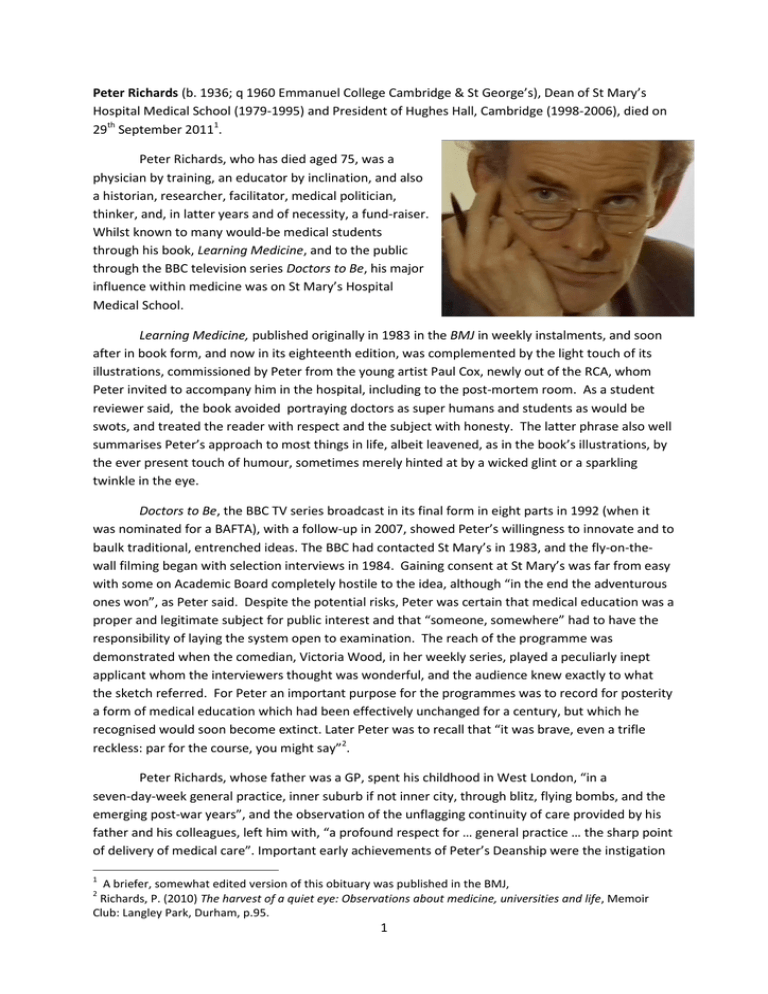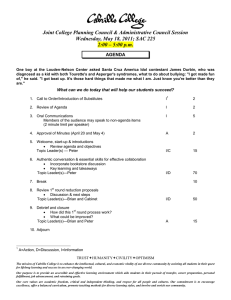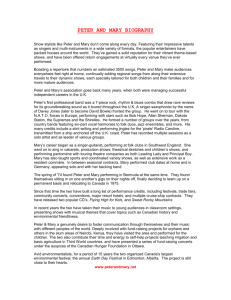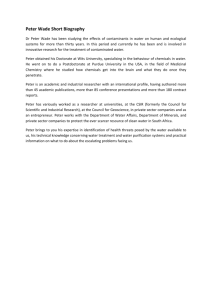Hospital Medical School (1979-1995) and President of Hughes Hall, Cambridge... 29 September 2011 Peter Richards
advertisement

Peter Richards (b. 1936; q 1960 Emmanuel College Cambridge & St George’s), Dean of St Mary’s Hospital Medical School (1979-1995) and President of Hughes Hall, Cambridge (1998-2006), died on 29th September 20111. Peter Richards, who has died aged 75, was a physician by training, an educator by inclination, and also a historian, researcher, facilitator, medical politician, thinker, and, in latter years and of necessity, a fund-raiser. Whilst known to many would-be medical students through his book, Learning Medicine, and to the public through the BBC television series Doctors to Be, his major influence within medicine was on St Mary’s Hospital Medical School. Learning Medicine, published originally in 1983 in the BMJ in weekly instalments, and soon after in book form, and now in its eighteenth edition, was complemented by the light touch of its illustrations, commissioned by Peter from the young artist Paul Cox, newly out of the RCA, whom Peter invited to accompany him in the hospital, including to the post-mortem room. As a student reviewer said, the book avoided portraying doctors as super humans and students as would be swots, and treated the reader with respect and the subject with honesty. The latter phrase also well summarises Peter’s approach to most things in life, albeit leavened, as in the book’s illustrations, by the ever present touch of humour, sometimes merely hinted at by a wicked glint or a sparkling twinkle in the eye. Doctors to Be, the BBC TV series broadcast in its final form in eight parts in 1992 (when it was nominated for a BAFTA), with a follow-up in 2007, showed Peter’s willingness to innovate and to baulk traditional, entrenched ideas. The BBC had contacted St Mary’s in 1983, and the fly-on-thewall filming began with selection interviews in 1984. Gaining consent at St Mary’s was far from easy with some on Academic Board completely hostile to the idea, although “in the end the adventurous ones won”, as Peter said. Despite the potential risks, Peter was certain that medical education was a proper and legitimate subject for public interest and that “someone, somewhere” had to have the responsibility of laying the system open to examination. The reach of the programme was demonstrated when the comedian, Victoria Wood, in her weekly series, played a peculiarly inept applicant whom the interviewers thought was wonderful, and the audience knew exactly to what the sketch referred. For Peter an important purpose for the programmes was to record for posterity a form of medical education which had been effectively unchanged for a century, but which he recognised would soon become extinct. Later Peter was to recall that “it was brave, even a trifle reckless: par for the course, you might say”2. Peter Richards, whose father was a GP, spent his childhood in West London, “in a seven-day-week general practice, inner suburb if not inner city, through blitz, flying bombs, and the emerging post-war years”, and the observation of the unflagging continuity of care provided by his father and his colleagues, left him with, “a profound respect for … general practice … the sharp point of delivery of medical care”. Important early achievements of Peter’s Deanship were the instigation 1 A briefer, somewhat edited version of this obituary was published in the BMJ, Richards, P. (2010) The harvest of a quiet eye: Observations about medicine, universities and life, Memoir Club: Langley Park, Durham, p.95. 2 1 in 1981 of what, for a decade, was the only full general practice rotation during the pre-registration house officer year, and the raising of the funds for a Chair and Department of Primary Care and General Practice at St Mary's, when such departments were still rare3. Peter studied medicine firstly at Emmanuel College, Cambridge, and then at St George’s Hospital Medical School. After qualifying in 1960, Peter worked at the Atkinson Morley Hospital, at the Hammersmith and in Winchester, and was then appointed consultant physician at St Peter’s Hospital, Chertsey, while also being an honorary part-time senior lecturer in Sir Stanley Peart’s unit at St Mary’s. In 1979 St Mary’s asked him to become a full-time Dean but he refused, saying “I doubted it would be good for St Mary’s to have a whole-time Dean and I was sure it wouldn’t be good for me, because I thoroughly enjoyed clinical medicine”4. Two months later he accepted the post after provision was made for several clinical sessions a week, Peter believing that a Dean had to continue to practise medicine or risk becoming out of touch. When he eventually resigned in 1995 he had become St Mary’s second longest-serving Dean. Being Dean got off to a difficult start for, “hardly had I arrived in 1979 when the ViceChancellor of the day, Lord Annan, … tried to close St Mary’s down … [alleging] that Mary’s compared poorly in facilities and cost with the Middlesex”5. It was the first of many medico-political battles, fought not only by using influences and friendships (the Queen Mother, Patron of St Mary’s, sent her secretary to tell Annan how displeased she would be), but also by a shrewd marshalling of statistical evidence. “That was my baptism. I had naively confused the great with the good”6. Peter became Dean of St Marys at a time of progressive change in the size, number and status of London teaching Hospitals and their medical schools. No longer could a Dean concentrate on the smooth running of the school, a matter of later regret, “I would have liked to have had much more time to deal with the educational issues. I actually thought that was what I was coming to do!”7. Instead a Dean had to participate positively and pro-actively in the cut and thrust of university and NHS policies. As early as 19868 Peter recognised that the future of London medical education lay in multi-faculty colleges and he made sure that St Mary’s joined early with Imperial College to create Imperial College of Science, Technology and Medicine. While at first there seemed little real change, gradually Imperial College expanded, incorporating Charing Cross and Westminster Hospital Medical School and the Royal Postgraduate Medical School, so that as Imperial College School of Medicine waxed, St Mary’s inevitably waned, In later years Peter acknowledged that bigger was not always better and that the leviathan-like structure of the present medical schools, hospitals and Trusts was probably too large. 3 Wilton,J. (1995) “Preregistration house officers in general practice”, BMJ 1995, 310: 369; see also http://www.rcgp.org.uk/about_us/history_heritage__archives/history__chronology/history_essay.aspx. 4 Richards, P. (2010) The harvest of a quiet eye: Observations about medicine, universities and life, Memoir Club: Langley Park, Durham, p.103 5 Richards, P. (2010) The harvest of a quiet eye: Observations about medicine, universities and life, Memoir Club: Langley Park, Durham, p.93. 6 Richards, P. (2010) The harvest of a quiet eye: Observations about medicine, universities and life, Memoir Club: Langley Park, Durham, p.94. 7 Garner, J.S. (1995) An interview with Professor Peter Richards, St Mary’s Gazette, 101 (3), 10-14; p.10. 8 Richards, P. (2010) The harvest of a quiet eye: Observations about medicine, universities and life, Memoir Club: Langley Park, Durham, p.100. 2 If students were the key to a medical school’s identity, selection of those students was a powerful weapon for forging that identity. On arriving as Dean, one of Peter’s first moves was to remove selection from the hands of the School Secretary and to take it over himself. Each of the (then) UCCA forms was read by him, and many of the applicants were themselves interviewed by Peter. Whatever the joking of Victoria Wood, there was a seriousness here, with a fundamental belief that academic ability mattered, but that character, motivation and what Peter called “potential” mattered as much. “We took risks on able individuals with real potential who, for one reason or another, had not yet had a fair chance to show it”9. Those characteristics were as likely to be found in those putting St Mary’s last on their form, rather than first, and all applicants were therefore treated seriously. The result was that within five years, a quarter of all medical school applications in the UK included St Marys. Despite the many political distractions, Peter contributed much to medical education at St Mary’s, not least by emphasising its over-riding importance, as for instance in strongly supporting the teaching of communication skills, an innovation which some senior medical school committee figures opposed because they feared it would encourage students to criticise consultants’ own style. Peter also strongly encouraged research into medical education, particularly of the three large cohort studies of student selection and training that began in 1980, 1985 and 1990 when applicants applied to St Marys, the most recent follow-up of which was in 2009. His contribution was at all levels, from proposing the studies in the first place, smoothing a host of minor problems, opening doors and unlocking filing cabinets, obtaining funding and writing emollient letters to grant-givers, finding cash when funding was not forthcoming, and, for the first survey, helping to staple several thousand questionnaires and sticking the letters in envelopes. Most important of all he had a vision, and realised that medical education needed, like so much else in medicine, to be evidence-based. Peter understood that St Mary’s was a complex social institution, running only because everyone served their part, and he saw a Dean’s role as conducting the orchestra, “to tap the best in each player and to weld their efforts together in harmony”10, as he put it in his regular and informal Dean’s Column in the St Mary’s Gazette. His inclusivity is well shown when he recalled with glee how one day the Domestic Supervisor called into his office at 7 a.m. with a letter from Buckingham Palace announcing that she was receive the British Empire Medal. “For once”, he said, “I felt the honours system was worthwhile”. That Peter himself never received any honour, one suspects because alienated some senior member of a committee, perhaps by too often telling the truth and standing for what he believed in, simply reflects badly on the honours system. Peter was, though, especially pleased to be honoured by the Finnish Government, being made a Knight of the White Rose. After leaving St Mary’s, Peter in 1998 was elected President of Hughes Hall, Cambridge (“the poorest in Cambridge”11) and immediately set about making it more attractive to students. In a move described as “visionary, courageous and slightly reckless”12, Peter obtained planning 9 Richards, P. (2010) The harvest of a quiet eye: Observations about medicine, universities and life, Memoir Club: Langley Park, Durham, p.95 10 Richards, P. (2010) The harvest of a quiet eye: Observations about medicine, universities and life, Memoir Club: Langley Park, Durham, p.66. 11 Richards, P. (2010) The harvest of a quiet eye: Observations about medicine, universities and life, Memoir Club: Langley Park, Durham, p.95 12 Richards, P. (2010) The harvest of a quiet eye: Observations about medicine, universities and life, Memoir Club: Langley Park, Durham,, p.95. 3 permission and pledged a million pounds he had not yet raised to build the Fenner’s Wing, a fivestorey building on the boundary of the university cricket ground, accepting in the process the risk of occasional broken windows. Its 73 student rooms, 6 graduate flats, and 100 seater dining room transformed the College, and gave Cambridge one of its most successful modern buildings; it surely cries out to be renamed as the Richards Building. Peter also obtained a Royal Charter granting Full College Status for Hughes Hall, although, in one of many stories that he tells so well in his memoirs The Harvest of a Quiet Eye (2010), it could not quite be granted before the end of his Presidency because it must be printed on vellum but both the sole supplier in the EU and the College of Heralds were out of stock13. As well as all his other activities, during this period , Peter somehow also found time to Chair the Professional Conduct Committee of the GMC. Peter had a shrewd and informed interest in history (which could have been an alternative vocation14), shown by his little known but very scholarly 1977 book, The Medieval Leper and his Northern Heir; it begins, “People are the theme of this book – people beneath the notice of history but for their disease”. Based on the 1958 essay that won him the Wallenberg Prize in Scandinavian Studies in Cambridge (where he had leaned Swedish on the side15), and becoming eventually the 1989 FitzPatrick Lecture to the Royal College of Physicians, the work originated in his own undergraduate travels around Denmark, where he helped with archaeological excavations, Sweden, Finland and, especially, the Åland islands. The recognition of the importance of history also resulted in the commissioning of the Canadian historian, Elsbeth Heaman, to write St Marys: The history of a London teaching hospital (2003). It contains a photo of Peter standing alongside a portrait of his predecessor, Sir Charles Wilson (Lord Moran), captioned, “The two ‘great deans’”). Heaman comments, “both Richards and Moran, in their own fashion, bolstered a student-centred culture at the school, which helped to forge a strong sense of self-confidence among the students and a strong corporate identity”. No better evidence could be found of Peter being a ‘great dean’ than an episode several years after he had left St Mary’s when the newly qualified students firstly had their photograph taken with the titular head of the medical school, and then went round the corner to have their picture taken with Peter, “the real dean”. Summing up Peter is not easy. To many, Peter was, “an enigmatic man, who took some time to understand, but could show warmth beneath a strongly academic attitude”16, and some senior colleagues certainly neither understood nor warmed to him, particularly the more conservative17. What is undoubted is the charisma, which underpinned respect and admiration amongst students and colleagues, and enabled the guiding motto of his deanship: ’The harder the task and the keener the risks, the greater the potential satisfaction’18. Although physically, “a small, thin man … with the half-moon spectacles, cerebral intensity and eloquence of an old-style Oxbridge don”19, 13 Richards, P. (2010) The harvest of a quiet eye: Observations about medicine, universities and life, Memoir Club: Langley Park, Durham, p.148. 14 Garner, J.S. (1995) “Of medicine and mergers: an interview with Professor Peter Richards”, St. Mary’s Gazette, 101 (3), 10-14. 15 Richards, P. (2010) The harvest of a quiet eye: Observations about medicine, universities and life, Memoir Club: Langley Park, Durham, p.101; Spindler, Doctors to Be, p.6. 16 Craig, J.O. Munk’s Roll, XII munksroll.rcplondon.ac.uk/Biography/Details/6458 17 Richards, P. (2010) The harvest of a quiet eye: Observations about medicine, universities and life, Memoir Club: Langley Park, Durham, p.96 18 Garner, J.S. (1995) “Of medicine and mergers: an interview with Professor Peter Richards”, St. Mary’s Gazette, 101 (3), 10-14. 19 Spindler, S. (1992) Doctors to Be, London: BBC Books, p.6. 4 encapsulating Peter’s personality is less easy. The student editor of the St Mary’s Gazette, when interviewing Peter on his retirement from St Mary’s, showed the several sides well: “There are those for whom he will remain an abstracted politico, wheeling and dealing in the corridors of power, selling St Mary’s soul to Imperial College according to some arcane Machiavellian realpolitik. Yet there will be many others who will remember his frequent visits last term to Queen’s Square to visit a seriously ill second-year student, his enthusiastic support at Rugby Club finals, his quiet pride at the annual St. Mary’s musical. They will remember his dignity, courage and humanity”20. Peter Richards had a son, Allan, and three daughters, Marianne, Annette and Christina, by his first wife, Anne Marie Larsen (m: 1959, diss: 1986). In 1987 he married Dr Carol Seymour, who survives him. Peter Richards BA 1957 MA 1961 MB BChir 1960 MD 1971 (Camb); PhD 1966 (Lond); MRCP 1962 FRCP 1976; FMedSci 1998 Acknowledgments: I am grateful to Mr Paul Cox, Dr Alasdair Frazer, Professor Brian Jarman, Mr Richard Wakeford and especially Professor Carol Seymour, for their comments and assistance with drafts of this obituary. The photograph used in this obituary was provided by Mr Richard Wakeford, and the version used in the BMJ obituary was made available with the assistance of Ms Susan Spindler. Chris McManus 20 Garner, J.S. (1995) “Of medicine and mergers: an interview with Professor Peter Richards”, St. Mary’s Gazette, 101 (3), 10-14. 5





